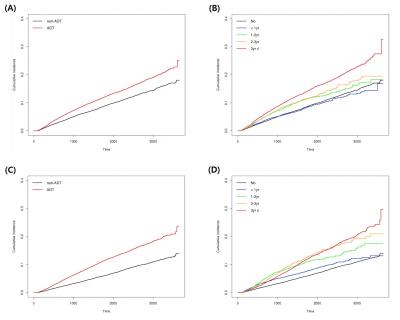|
Cancer - Prostate(구연)
|
(E-126)
|
|
|
전립선 암 환자에서 안드로겐 박탈 요법과 새로 발생된 골절 위험 : 코호트 연구 |
¹순천향대학교병원
²연세의대 강남세브란스병원
³연세의과대학 |
| 김도경¹김종원²이혜선³박주영³안현규²하지수²조강수² |
Background: We evaluated the risk of osteoporosis and fractures associated with androgen deprivation therapy (ADT) use and duration in men with prostate cancer.
Methods: From the nationwide claims database in South Korea, a total of 218,203 men with prostate cancer were identified between 2008 and 2017. After applying the inclusion and exclusion criteria, a total of 144,670 patients were included in the analysis. To adjust for comorbidities between cohorts, 1:1 propensity score matching was used. Cox proportional hazard regression models were used to estimate adjusted hazard ratios (HRs) and 95% confidence intervals (CIs) of events associated with ADT, after controlling for potential confounding factors.
Results: In the matched cohort (n = 61,274), there were differences in the incidence of newly developed osteoporosis (8.79% in the ADT group vs. 7.08% in the non-ADT group, p < 0.0001) and fractures (8.12% in the ADT group vs. 5.04% in the non-ADT group, p < 0.0001). Age-adjusted Cox regression analysis revealed that the ADT group had a significantly higher risk of osteoporosis (HR, 1.381; 95% CI, 1.305–1.461; p < 0.0001) and fractures (HR, 1.815; 95% CI; 1.703–1.935; p < 0.0001) compared to the non-ADT group. Furthermore, the risk of osteoporosis and fractures increased as the duration of ADT increased, although concurrent use of anti-androgens did not increase the adverse effects.
Conclusion: The use of ADT was associated with an increased risk of osteoporosis and fractures in prostate cancer patients. Clinicians should be mindful of the risk of osteoporosis and fractures when administering ADT for prostate cancer.
|
 |
|
keywords : Androgen deprivation therapy, Prostate cancer, Fracture |
|

